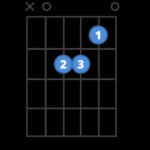Been playing guitar and struggling to nail those chords? After 20 years of teaching, I can tell you, almost every time a beginner has trouble with A Chord Guitar, it boils down to one thing: poor wrist and elbow position. It’s the most common issue, and luckily, it’s usually a pretty straightforward fix.
The Beginner’s Grip: Why It Doesn’t Work
Many beginners naturally start by cradling the guitar neck in the palm of their hand. It feels intuitive, right? The problem is, holding the neck like this makes it incredibly difficult to wrap your fingers around the fretboard properly. This is the number one mistake I see, and because so many people are self-taught these days, it’s a problem that pops up everywhere.
If you find yourself needing to squeeze the neck with your fretting hand just to keep the guitar in place, that’s a red flag. You shouldn’t have to rely on your left hand for support. Ideally, you should be able to remove your fretting hand completely, and the guitar should stay put. If it doesn’t, you need to rethink how you’re holding the instrument. Consider adjusting your right arm position, exploring the “classical” guitar posture, or using a strap, even when sitting. Playing with a strap, even seated, can make a huge difference in freeing up your fretting hand.
Wrist, Thumb, and Elbow: The Golden Triangle of Chord Mastery
Once your guitar is properly supported, let’s talk about hand positioning. For playing a chord guitar effectively, think about these key points:
- Wrist Position: Your wrist should have a slight outward curve. Avoid letting it collapse inwards towards the guitar neck.
- Thumb Position: Keep your thumb flat and positioned in the middle of the back of the guitar neck. It shouldn’t be bent at the joint or hooked around the side of the neck.
- Elbow Position: Generally, keeping your elbow fairly close to your side is best. This position naturally rotates your hand so your fingers align parallel to the fretboard, which is what you want for reaching up and down the neck and playing most chords.
The A Chord Exception: A Slight Elbow Adjustment
While the “elbow in” position is a good general rule, there are exceptions. Take the A chord, for example. For this chord, slightly pushing your elbow out can actually be helpful. This outward elbow movement rotates your hand in a way that makes it easier to bring your fingers across the fretboard. This is particularly useful for getting those three fingers clustered together to form a clean A major chord. Experiment with this slight elbow adjustment and see how it improves your a chord guitar playing.
Unlock Your Chord Potential
Getting comfortable and accurate with a chord guitar and many others really comes down to these fundamental hand and elbow positions. By addressing these often-overlooked aspects of your technique, you’ll likely find chords become much easier to play, and your overall guitar playing will improve dramatically. It’s not about finger strength, it’s about smart positioning!

